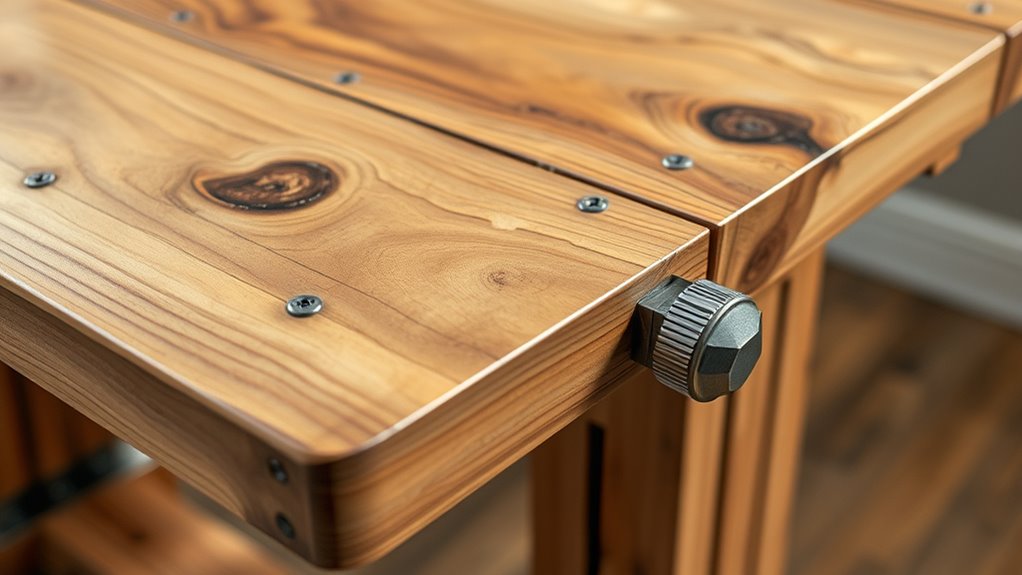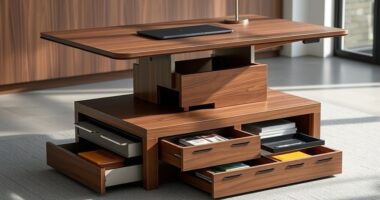To build an adjustable height standing desk with shop offcuts, select sturdy materials like reclaimed wood and metal parts that support your equipment. Use versatile offcuts such as plywood or leftover lumber for the main surface, adding metal brackets or threaded rods for smooth height adjustments. Focus on proper weight distribution and stability, tailoring the design to your ergonomic needs. Keep exploring for detailed steps and tips on creating a safe, beautiful workspace with your leftover materials.
Key Takeaways
- Select sturdy, smooth-surfaced wood or plywood scraps for a durable, easy-to-assemble tabletop and frame.
- Use metal brackets, threaded rods, or telescoping legs from shop offcuts to create adjustable height mechanisms.
- Measure ergonomic heights accurately to customize the desk for comfortable standing and sitting positions.
- Reinforce structural stability with corner braces and proper weight distribution to prevent wobbling during adjustments.
- Finish surfaces with sanding and sealing for safety, aesthetics, and easy cleaning, incorporating natural materials for a pleasing look.

If you spend long hours at your desk, building an adjustable height standing desk can boost your comfort and productivity. When you tailor your workspace to your needs, you reduce strain and enhance focus. One of the key advantages of a DIY standing desk is the ability to customize it for best ergonomic benefits. By designing it to match your height and working habits, you can minimize neck, back, and wrist discomfort. This means you’ll stay more alert and less prone to fatigue throughout your workday. Incorporating natural materials like wood can also add to the aesthetic appeal and sustainability of your project.
Building an adjustable standing desk tailored to your needs boosts comfort and productivity all day long.
Material selection plays an essential role in creating a sturdy, durable, and safe standing desk from shop offcuts. You want to choose materials that can support the weight of your equipment while remaining easy to work with. Solid wood or plywood often work well because they’re strong, relatively lightweight, and easy to cut and assemble. Reclaimed or leftover lumber from previous projects can be perfect for this purpose, helping you reduce waste and keep costs down. Metal brackets or corner braces can reinforce the structure, ensuring stability when you adjust the height. Avoid flimsy materials that might wobble or warp over time, as this can compromise both safety and ergonomics.
When selecting materials, consider their finish and surface quality. A smooth, sealed surface prevents splinters and makes cleaning easier, maintaining a safe workspace. If you’re using rough wood, a simple sanding and sealing process can improve both safety and appearance. For the adjustable mechanism, you might use metal pipes, threaded rods, or telescoping legs made from offcuts, ensuring they’re compatible and strong enough to handle frequent adjustments. Be mindful of the weight distribution; a well-balanced design prevents tipping or instability when you change heights.
Incorporating ergonomic benefits into your build means paying attention to the details. Measure your standing and sitting heights accurately to set the best working level. Think about adding features like a keyboard tray or monitor riser, which can be made from leftover pieces, to keep everything at eye and arm level. This customization ensures your posture stays correct, reducing discomfort over time.
Frequently Asked Questions
What Tools Are Needed for Assembly?
To assemble your adjustable height standing desk, you’ll need basic tools like a drill, screwdriver, measuring tape, and possibly a saw for cut adjustments. As you put it together, consider DIY cable management to keep cords organized and safe. Don’t forget ergonomic accessories like a wrist rest or monitor stand to enhance comfort. These tools and accessories help you create a functional, customized workspace that promotes good posture and productivity.
How Do I Ensure Stability at Different Heights?
Did you know that an adjustable desk can reduce back pain by up to 32%? To guarantee stability at different heights, focus on strong, quality material selection like solid wood or metal. Reinforce joints with braces or screws, and use locking mechanisms to keep the desk steady. Proper design and sturdy materials provide ergonomic benefits, making your workspace safer and more comfortable across all height settings.
Can I Customize the Desk Size?
You can definitely customize the desk size to fit your space and needs. When doing so, consider the ergonomic benefits of the desk to guarantee comfort, and select materials that are sturdy and lightweight. Adjust the width and depth to match your workspace, and tailor the height range for maximum ergonomic positioning. Proper material selection also enhances stability at different heights, making your custom desk both functional and comfortable.
What Safety Precautions Should I Take?
Prioritize protection by practicing proper precautions. Carefully check the material safety of your shop offcuts to prevent hazards. Use personal protective equipment like gloves and goggles to guard against splinters and dust. Make certain all tools are in tip-top shape, and work in a well-ventilated workspace. These precautions promote ergonomic benefits, ensuring your DIY desk is safe and sturdy, so you can comfortably customize your workspace without worry.
How Do I Adjust the Desk Height Easily?
To easily adjust your desk height, incorporate a simple mechanism like a screw or a pneumatic lift, guaranteeing smooth transitions. This helps you maintain an ergonomic posture and reduces strain during work. Keep your workspace organized by placing adjustment tools nearby, so you can make changes quickly. Regularly check the stability after adjustments to guarantee safety, and practice adjusting the desk to become more efficient over time.
Conclusion
Now, with your new adjustable standing desk, you’ve crafted a tool as versatile as a Swiss Army knife, ready to adapt to your daily needs. Just like a trusty sidekick from your favorite adventure, it’s there to keep you comfortable and energized, whether you’re working or taking a quick break. Embrace this DIY triumph, and remember, even heroes need a good setup—yours just happens to be made from clever offcuts!









